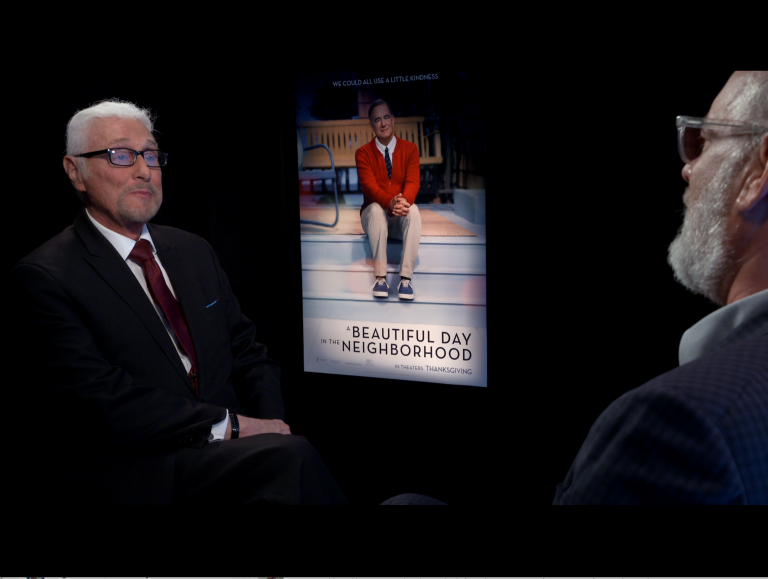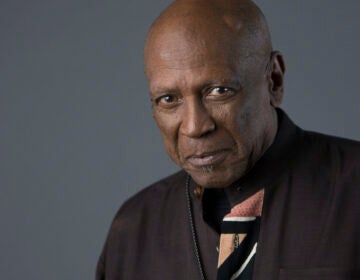And the Best Picture Oscar goes to… the film that reaches the ‘magic number’
WHYY film critic and “Flicks” host Patrick Stoner explains the Academy Awards’ nominating process for best picture ahead of this weekend’s ceremony.
Listen 5:07
Film critic Patrick Stoner (left) interviews Tom Hanks (right) for his movie, "A Beautiful Day in the Neighborhood," where Hanks plays Fred Rogers. (Flicks)
The Academy Awards, honoring creatives in the film industry, are Sunday night.
There will be Oscar de la Renta designs on the red carpet and then Oscar statuettes in the hands of actors and filmmakers.
After all the glitz and glam and acceptance speeches, nearly year after year, someone cries foul, that the Best Picture wasn’t really the best or that selections lack diversity.
WHYY’s Patrick Stoner, movie critic and host of “Flicks” says Best Picture has to reach a “magic number.” He does the math and talks about some basic Academy Awards’ selection rules with Morning Edition host Jennifer Lynn.
–
Good morning, Jennifer.
Do we need a calculator to have this conversation?
It’s complicated, but we have the brightest listeners in all of the country. They’ll be able to follow it.
So how do films and people in the film industry get nominated for an Oscar? Just in general?
Well, there are about, oh, 8,000 members of the Academy. It’s divided into 17 different groups, plus a couple of extra that they created just because some people don’t fit into those groups. But the way it works is all of the nominations come out of these specific craft area. For example, directors will nominate directors. Cinematographers will nominate cinematographers. The only thing that everybody gets to have a voice in is Best Picture. But Best Picture is entirely different.
Gets a little tricky here. So everybody pay attention.
Yes. Now sit back, relax, sip something nicely. There can be up to 10 nominations for Best Picture. And this year, just as it was in 2019, there are nine. And the way it works is you vote your preference: One, two, three, four, whatever. Now it’s really quite simple. If one film immediately gets 50% plus one, that’s the magic number. You’ve got your Best Picture. But with nine, you can see how that might not happen. Say you only get 46%. Well, at that point, the lowest one is eliminated — the number ninth one — and their votes are redistributed. So that changes things. Now, does one picture get 50% plus one? If not, they eliminate the next one. And those votes are redistributed.
Consider a situation where the film that almost immediately won. Once the redistributing happens, the film drops to second place or third place, maybe even last place. Now, Patrick, help us with a scenario, maybe an example, some situation where this could be happening, is happening.
I can’t do it with the votes because, boy, have they been good about keeping the voting secret. There’s not been a leak in all of these years as to the actual voting. But consider the famous year where the wrong Best Picture winner was announced. Remember “La La Land?” And then, wait a minute, wait a minute, wait a minute. And it was “Moonlight.” Well, “La La Land” was the favorite to win. Now we don’t know. But what if “La La Land” didn’t quite get that 50% plus one? And when they cut out the bottom and redistributed either in that time or the next time, “Moonlight” went above it because it was a strong second place choice of almost everybody. That could happen.
How do you become a member of the Academy? It seems like an exclusive club.
Each craft area has its own criteria for membership in that craft area. So we won’t run through them all. Let’s just put it this way: You will have achieved a level of success. You have to have had X number of films, been awarded by other organizations and what have you, or you can just be voted in directly as they did when they decided to increase the diversity because they wanted to increase women and minorities.
Yeah, there’s been pressure by the voting system and outside the voting system to make some change.
And more will be made, and more need to be made, frankly. I think maybe the most controversial area is of directors, women.
While we have you, Patrick, why are the Oscar statuettes called Oscars?
Some debate about that. Betty Davis claimed she named it, but the generally accepted thing was that when they developed the first statuette, one of the people connected with the organization at that time said, “That looks just like my Uncle Oscar.” And that got picked up and used forever.
So it could have been Uncle Ernie or Harold.
Absolutely. Or better, Uncle Patrick. It could be the Patricks that are being handed out! Oh, gosh, I showed my ego there.
It’s okay! Well, WHYY’s Patrick Stoner, movie critic and host of “Flicks,” thank you for covering the basics.
Always good, Jennifer.
WHYY is your source for fact-based, in-depth journalism and information. As a nonprofit organization, we rely on financial support from readers like you. Please give today.





